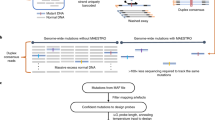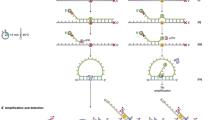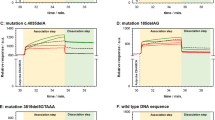Abstract
The ability to scan a large gene rapidly and accurately for all possible heterozygous mutations in large numbers of patient samples will be critical for the future of medicine. We have designed high–density arrays consisting of over 96,600 oligonucleotides 20–nucleotides (nt) in length to screen for a wide range of heterozygous mutations in the 3.45–kilobases (kb) exon 11 of the hereditary breast and ovarian cancer gene BRCA1. Reference and test samples were co–hybridized to these arrays and differences in hybridization patterns quantitated by two–colour analysis. Fourteen of fifteen patient samples with known mutations were accurately diagnosed, and no false positive mutations were identified in 20 control samples. Eight single nucleotide polymorphisms were also readily detected. DNA chip–based assays may provide a valuable new technology for high–throughput cost–efficient detection of genetic alterations.
This is a preview of subscription content, access via your institution
Access options
Subscribe to this journal
Receive 12 print issues and online access
$209.00 per year
only $17.42 per issue
Buy this article
- Purchase on Springer Link
- Instant access to full article PDF
Prices may be subject to local taxes which are calculated during checkout
Similar content being viewed by others
References
Hall, J. et al. Linkage of early-onset familial breast cancer to chromosome 17q21. Science 250, 1684–1689 (1990).
Narod, S. et al. Familial breast-ovarian cancer locus on chromosome 17q12–q23. Lancet 338, 82–83 (1991).
Easton, D.F. et al. Genetic analysis in familial breast and ovarian cancer. Results from 214 families. Am. J. Hum. Genet. 52, 678–701 (1993).
Rowell, S., Newman, B., Boyd, J. & King, M.C. Inherited predisposition to breast and ovarian cancer. Am. J. Hum. Genet. 55, 861–865 (1994).
Ford, D. and the Breast Cancer Linkage Consortium. Risks of cancer in BRCA1 -mutation carriers. Lancet 343, 692–695 (1994).
Miki, Y. et al. A strong candidate for the breast and ovarian cancer susceptibility gene BRCA1 . Science 266, 66–71 (1994).
Shattuck-Eidens, D. et al. A collaborative survey of 80 mutations in the BRCA1 breast and ovarian cancer susceptibility gene. Implications for presymptomatic testing and screening. J. Am. Med. Assoc. 273, 535–541 (1995).
A comprehensive listing of BRCA1 mutations and mutation screening protocols can be found in the Breast Cancer Information Core Database located on the World Wide Web at http://www.nchgr.nih.gov/lntramural_ research/Lab_transfer/Bic/.
Struewing, J.P. et al. Detection of eight BRCA1 mutations in 10 breast/ovarian cancer families, including one family with male breast cancer. Am J. Hum. Genet. 57, 1–7 (1995).
Struewing, J.P. et al. The carrier frequency of the BRCA1 185delAG mutation is approximately 1 percent in Ashkenazi Jewish individuals. Nature Genet. 11, 198–200 (1995).
Tonin, P. et al. BRCA1 mutations in Ashkenazi Jewish women. Am. J. Hum. Genet. 57, 189 (1995).
Friedman, L.S. et al. Novel inherited mutations and expressivity of BRCA1 alleles, including the founder mutation 185delAG in Ashkenazi Jewish families. Am. J. Hum. Genet. 57, 1284–1297 (1995).
FitzGerald, M.G. et al. Germ-line BRCA1 mutations in Jewish and non-Jewish women with early-onset breast cancer. N. Engl. J. Med. 334, 143–149 (1996).
Offit, K. et al. Germline BRCA1 185delAG mutations in Jewish women with breast cancer. Lancet 347, 1643–1645 (1996).
Castilla, L.H. et al. Mutations in the BRCA1 gene in families with early-onset breast and ovarian cancer. Nature Genet. 8, 387–391 (1994).
Friedman, L.S. et al. Confirmation of BRCA1 by analysis of germline mutations linked to breast and ovarian cancer in ten families. Nature Genet. 8, 399–404 (1994).
Simard, J. et al. Common origins of BRCA1 in Canadian breast and ovarian cancer families. Nature Genet. 8, 392–398 (1994).
Hogervorst, F.B.L. et at. Rapid detection of BRCA1 mutations by the protein truncation test. Nature Genet. 10, 208–212 (1995).
Gayther, S.A. et al. Rapid detection of regionally clustered germ-line BRCA1 mutations by multiplex heteroduplex analysis. Am. J. Hum. Genet. 58, 451–456 (1996).
Gayther, S.A. et al. Germline mutations of the BRCA1 gene in breast and ovarian cancer families provide evidence for a genotype-phenotype correlation. Nature Genet. 11, 428–433 (1995).
Fodor, S.P.A. et al. Light-directed spatially addressable parallel chemical synthesis. Science 251, 767–773 (1991).
Pease, A.C. et al. Light-generated oligonucleotide arrays for rapid DNA sequence analysis. Proc. Natl. Acad. Sci. USA 91, 5022–5026 (1994).
Cronin, M.T. et al. Cystic fibrosis mutation detection by hybridization to light-generated DNA probe arrays. Hum. Mut. 7, 244–255 (1996).
Lipshutz, R.J. et al. Using oligonucleotide arrays to probe genetic diversity. BioTechniques 19, 442–447 (1995).
Kozal, M.J. et al. Extensive polymorphisms observed in HIV-1 clade B protease gene using high density oligonucleotide arrays. Nature Med. 2, 753–759 (1996).
Yershov, G. et al. DNA analysis and diagnostics on oligonucleotide microchips. Proc. Natl. Acad. Sci. USA 93, 491–4918 (1996).
Chee, M.S. et al. Accessing genetic information with high-density DNA arrays. Science 274, 610–614 (1996).
Houldsworth, J. & Chaganti, R.S. Comparative genomic hybridization: an overview. Am. J. Pathol. 145, 1253–1260 (1994).
Durocher, F. et al. Comparison of BRCA1 polymorphisms, rare sequence variants and/or missense mutations in unaffected and breast/ovarian cancer populations. Hum. Mol. Genet. 5, 835–842 (1996).
Chapman, M.S. & Verma, I.M. Transcriptional activation by BRCA1 . Nature 382, 678–679 (1996).
Author information
Authors and Affiliations
Rights and permissions
About this article
Cite this article
Hacia, J., Brody, L., Chee, M. et al. Detection of heterozygous mutations in BRCA1 using high density oligonucleotide arrays and two–colour fluorescence analysis. Nat Genet 14, 441–447 (1996). https://doi.org/10.1038/ng1296-441
Received:
Accepted:
Issue Date:
DOI: https://doi.org/10.1038/ng1296-441
This article is cited by
-
Variations on a Chip: Technologies of Difference in Human Genetics Research
Journal of the History of Biology (2018)
-
Fluorescence polarization gene assay for HIV-DNA based on the use of dendrite-modified gold nanoparticles acting as signal amplifiers
Microchimica Acta (2018)
-
Dual functional Phi29 DNA polymerase-triggered exponential rolling circle amplification for sequence-specific detection of target DNA embedded in long-stranded genomic DNA
Scientific Reports (2017)
-
High-throughput resequencing in the diagnosis of BRCA1/2 mutations using oligonucleotide resequencing microarrays
Breast Cancer Research and Treatment (2010)



